FCAW vs MIG Welding: Differences & When to Use Them
Last Updated on
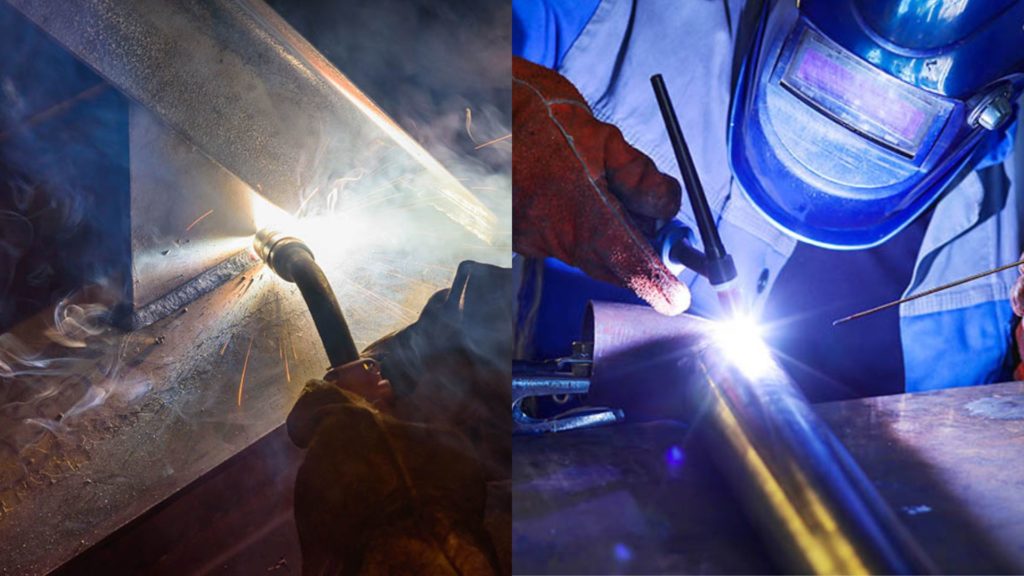
Aside from automated welding processes, FCAW (flux-cored arc welding) and MIG (Metal Inert Gas) welding are the two most efficient welding processes out there. Both machines have a welding gun that strikes an arc with the pull of a trigger, feeds the filler metal from a roll of wire, and has adjustable parameters on the machine that stay relatively consistent. They are known as ‘semi-automatic’ processes and are very user-friendly processes overall. However, they are distinct from each other.
What is the primary difference between FCAW and MIG, also called GMAW (Gas Metal Arc Welding)? The difference is not in the equipment. They both use MIG equipment, and FCAW is sometimes called MIG flux-core. The primary difference is the wire that is used. Aside from the wire, let’s take a look at what makes each of them unique.
Overview of FCAW
FCAW (flux-core arc welding) is a semi-automatic welding process that uses a constant voltage power source on a welder/inverter where the voltage is set on the machine and stays relatively consistent throughout the welding process. A wire feeder is attached to the machine. This feeder holds a roll of welding wire, which functions as the filler metal for the weld. A welding gun dispenses it at the pull of a trigger.
The lead is known as the electrode side of the circuit. On the other side of the circuit is the welding ground clamp. The gun also uses diffused shielding gas (depending on the exact process) that helps to cover the weld zone and protect the molten metal from outside contaminants as it cools. The gas comes out of a diffuser just below the contact tip.
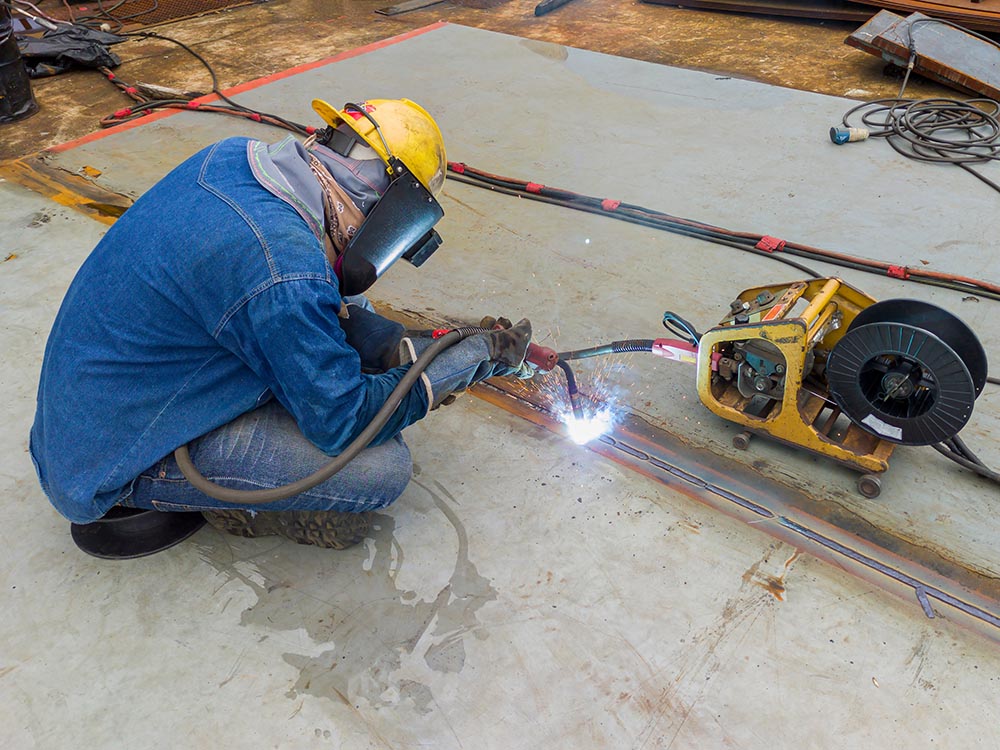
How it Works
FCAW is characterized by the type of wire used. The tubular welding wire contains a flux that helps create a protective slag and a cloud of protective gas that shields the weld in its molten state from harmful things in the atmosphere.
When the welder pulls the trigger on the gun, they strike an arc (up to 11,000° F!) on the workpiece. This occurs because the current flows through the circuit created between the positive and negative of the power source.
However, the arc will not begin without the contact tip installed at the end of the gun, through which the wire feeds. This arc creates a molten weld pool where the filler wire from the gun is dispensed and fills the molten crater created by the arc. This creates a fusion of the base material and the filler wire. The result of the fusion is known as the weld, and the slag is then chipped off.
There are two different types of FCAW. The first is called self-shielded (FCAW-S). This process provides shielding of the molten weld pool exclusively from the flux in the wire. The second type is called dual shield (FCAW-G). It uses a separate type of flux-cored wire that is aided by additional protection from a shielding gas, either carbon dioxide or a mix of argon and carbon dioxide. This type of flux-cored wire cannot be used by itself.
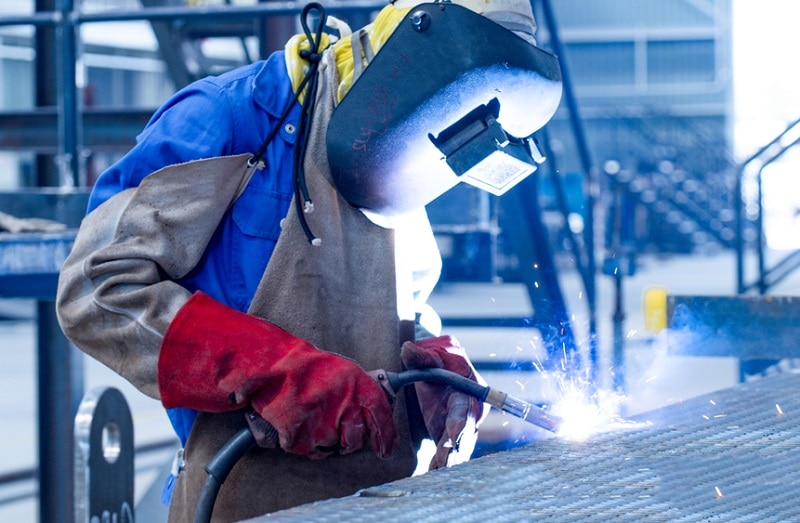
When to Use FCAW
Flux-core is the ideal process to use for production welding on structural steel. Its advantage is that its deposition rate (the rate at which filler metal is deposited) is almost ten times higher than conventional stick welding. In addition, FCAW also provides excellent penetration comparable to stick.
In an indoor fabrication environment, workers will most often use dual shield as it welds much more smoothly. However, dual shield technically should not be used outdoors. A light breeze can blow away the shielding gas leaving the weld with sub-optimal protection from contaminants. This can cause weld defects such as porosity. For this reason, self-shielded flux-core is preferred for outdoor use.
- Extremely efficient at depositing weld
- Equipment is intuitive to use
- Good weld penetration
- A lot of equipment can be difficult to transport
- Extra fumes from flux can be hazardous with long-term exposure
Overview of MIG
MIG welding uses the same equipment as FCAW except for the type of wire. MIG is sometimes called solid wire because it contains no flux. It is a hard wire that is deposited into the weld, and the protection of the molten weld pool is provided exclusively by the external shielding gas.
MIG stands for Metal Inert Gas because the gases are not active. They push away oxygen, for example. Gas Metal Arc Welding (GMAW) is technically the most commonly accepted name because some processes utilize 2% oxygen, like spray MIG.
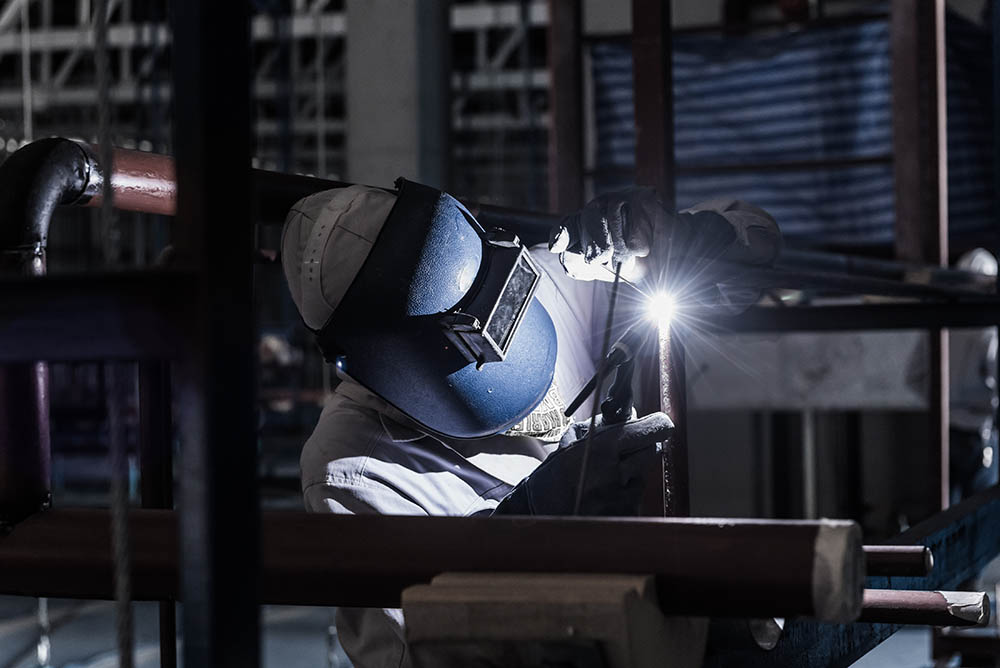
How it Works
Like FCAW, the wire is dispensed at the pull of a trigger, and the contact tip helps to conduct the current through the circuit, thereby striking an arc. The filler metal is melted off into droplets (not distinctly visible to the human eye), which then fall into the weld pool; this creates the fusion. The best part about MIG is that there is no slag, and no cleanup is required. Sometimes some glossy silicon (part of the wire) residue will be left on top of the weld, but it is harmless. MIG differs from flux core because more combinations of shielding gas are used depending on the exact process, and they tend to be more expensive.
We can break down MIG into four different processes. The most commonly used by hobbyists is short-arc transfer. It creates a small weld puddle characterized by its fast freezing. This is because it uses significantly less voltage than other MIG processes. It’s not great for thicker material because it doesn’t give a ton of weld penetration, but it’s good for thinner materials like sheet metal.
You can also try globular transfer. It is like short arc, except the droplets deposited are bigger and more globular. Spray arc is a stream of droplets entering the weld pool. Pulse is a kind of spray MIG where the voltage pulses up and down, causing the metal to travel the gap between the wire and weld pool. The advantage of pulse is that because the voltage is not consistently high, it helps minimize unnecessary heat input into the base material.
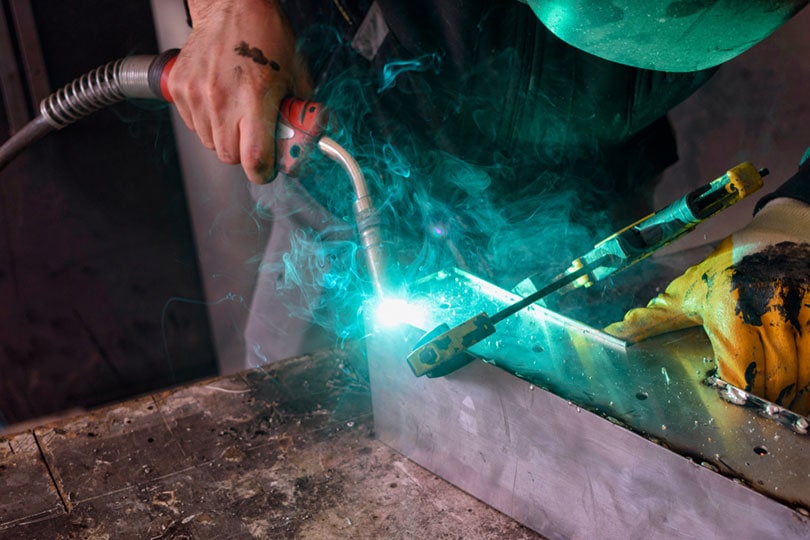
When to Use MIG
MIG is great for thinner materials and, unlike FCAW, can be used on more than just steel. FCAW can be used on other metals, but the WPS (Welding Procedure Specification) for such welds tends to be a bit more complicated.
MIG welding aluminum and stainless is far more common. MIG is a great choice when you need to make a small weld. Next time you’re at the gym, look at the exercise equipment and machines. A lot of the welds there are made with MIG short arc. Since not much stress is applied directly to these welded areas, it’s okay to weld them with MIG. MIG is not preferred for structural steel.
- Easy to use
- Hardly any cleanup
- Not as much penetration
- Shielding gas is more expensive
Frequently Asked Questions (FAQs)
Is Flux Core Welding Toxic?
Yes. Although you won’t feel the effects of them right away, you might suffer something long-term. Compared to MIG, FCAW is far more toxic to weld because of fumes created not only from the wire but from the slag and mill scale as well. All of these materials send particles into the the air while you are welding flux core. This is why it’s important to get a suitable respirator or fresh air welding hood.
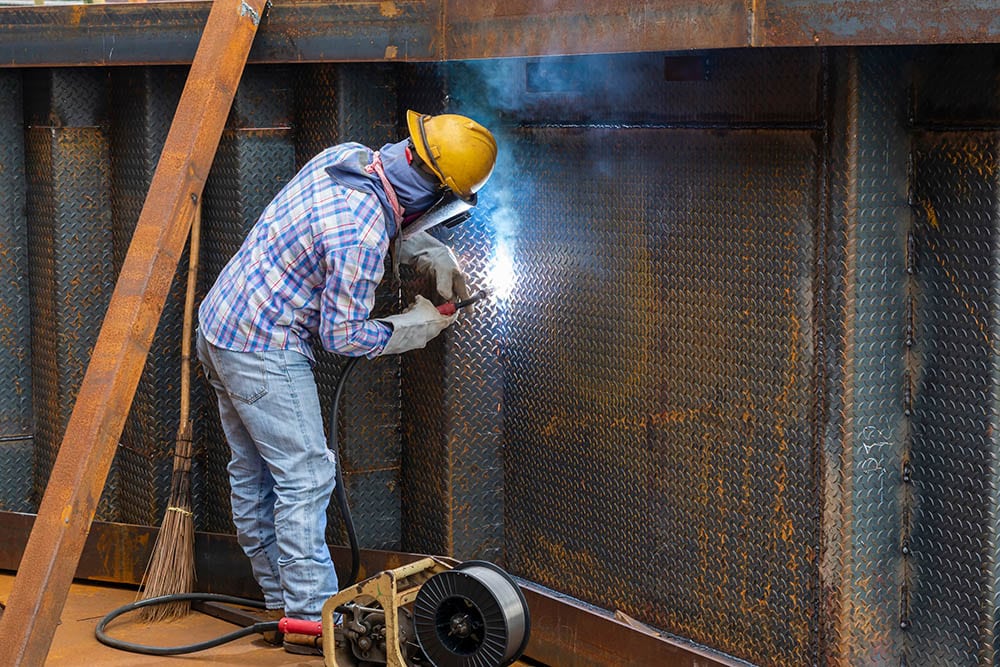
Is FCAW Stronger Than MIG?
FCAW and MIG make similar strength welds. MIG gets a bad reputation for lack of penetration because it cannot reasonably be used on the same surfaces that FCAW can. FCAW can weld through things like mill scale and dust, but MIG requires that you clean all the surfaces that need to be welded.
So, if you weld the same type of joint, FCAW will have an easier time because it will burn up the mill scale. MIG will be prevented from having good penetration because of this. But if the joint is cleaned well enough, MIG can make just as strong of welds. It’s just not feasible for certain projects.
Can You Weld Dual Shield Flux Core Outside?
Officially, no, you cannot weld dual shield outside If you create a self-contained area for your welding that shields your work from the wind, then welding dual shield is possible.
However, even in these circumstances, you’ll have to turn the regulator up on your gas bottle. While this is not necessarily unsafe, it will do damage to your regulator and other equipment over time. You have to turn it up so high to compensate for the loss of shielding gas from the wind. Even if it’s cranked up, you still won’t be able to guarantee that you’ll have proper coverage. This is why self-shielded flux core is preferred for outdoor welding.
Why Is It Important To Remove Slag from the Weld?
Slag leftover from a flux core weld (or SMAW, for that matter) will contaminate subsequent welds. It will then cause a lack of fusion due to slag inclusions. Lack of fusion means your weld is sitting on top of the base material. Slag inclusions can also cause porosity and pinholes. There are extremely rare exceptions where slag does not have to be removed, and that is not according to welding code but practical advice.
If you run a root pass, you must remove all slag. However, if you are going to run two fillets on top to create a 3/8” weld overall, for example, sometimes you can leave the slag on one of the fillets. The reason is that the material is already so hot, and the next weld will melt away the slag and burn it up into the air like nothing. However, this is far from recommended. Some welders do this out of convenience to avoid chipping the slag, and some do it because it creates a nicer overall appearance.
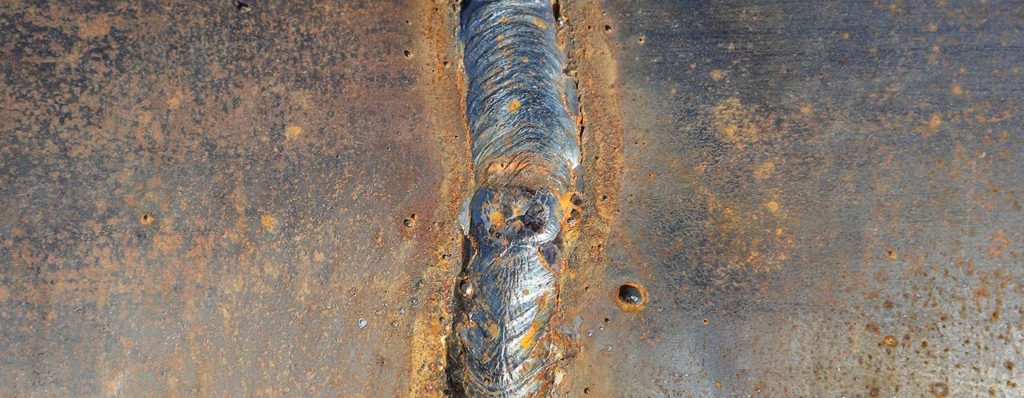
- Welding thinner gauge metal
- Welding aluminum
- Small home repairs
- Structural steel
- Welding outdoors in the wind
- When more penetration is required
Final Thoughts
Overall, these two processes are among the easiest and most intuitive to learn. Just remember to avoid MIG welding outside, or you will end up with Swiss cheese A.K.A. significant porosity in your welds. If you are welding flux core, don’t forget to remove your slag. Leave your hood down when you chip it as well since you could end up with a piece straight to the face!
See Also: FCAW vs GMAW: Differences, & When to Use Them
Featured Image Credit: (L) N_Sakarin, Shutterstock | (R) Marina Lohrbach, Shutterstock
